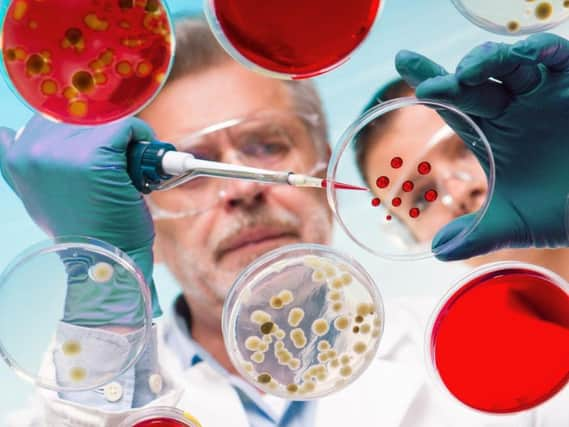What is the biggest challenge to growing Scotland's life sciences sector and how can it be overcome?


Catherine Calderwood Chief Medical Officer, Scotland
Brexit. In common with other sectors, life sciences face the challenge of operating in a highly competitive global market, with cost and currency volatility.


The sector also has the huge uncertainty of a largely unknown commercial, regulatory and labour market should the UK leave the European Union and the single market. This will likely exacerbate those challenges.
Advertisement
Hide AdAdvertisement
Hide AdThe NHS in Scotland has a strong track record in supporting the sector, both in terms of hosting research studies and clinical trials and, increasingly, in working in collaboration with industry on innovative medicines, therapies and products.
The NHS alone cannot, of course, address all the challenges facing industry, but it can contribute to the sector’s ambitions for growth and provide some local certainty for the future by deepening its collaborative working with industry partners and, where possible, streamlining and simplifying processes that can support the adoption and spread of innovation across Scotland’s NHS.
Jamal Rushdy Chief executive, Collagen Solutions
We are in a specialised area of life sciences, being a biomaterials firm focused on regenerative medicine.
Because what we do touches so many major medical technology markets – including orthopaedics, cardiovascular, dental, wound care, neurology and basic research – one of our biggest challenges is building the network of advisers, clinicians, service providers and industry contacts in many of these areas as new opportunities arise.
Based in Glasgow, we have access to excellent scientific and technical resources from Glasgow University, Strathclyde University and in Edinburgh the MRC Centre for Regenerative Medicine.
In fact, the World Biomaterials Congress in 2020 will be held in Glasgow.
We are actively seeking opportunities for networking meetings and workshops that bring scientific researchers from these academic centres together with Scottish life sciences companies to develop this network and advance the regenerative medicine field.
The continued valuable support of Scottish Enterprise and Scottish Development International is also critical to the growth of the sector in Scotland.
Michael Leek Chief executive, TC BioPharm
Advertisement
Hide AdAdvertisement
Hide AdThe biggest challenge to growing life sciences in Scotland is people.
We need individuals with drive, passion and entrepreneurial flair, tempered by folk with years of biotech and pharma development experience.
We need people with ambition and drive, willingness and desire to take the risks needed to grow crazy ideas into blockbuster drugs.
To succeed in growing Scotland’s life sciences sector, it is essential we foster a culture of self-belief, encouraging innovation and creativity, providing an environment that inspires, challenges and nurtures in equal amounts.
Without people, without passion, without ambition, there would be no new biotech blockbusters.
Dr Siobhán Jordan Director, Interface
Scotland punches well above its weight when it comes to life sciences, with a heady list of innovation and inventions.
The biggest challenge is keeping the momentum going. We have a good opportunity to do that with the Scottish Government’s ambition to create an £8 billion industry by 2025.
There is an incredible amount of activity in the sector, with companies large and small making an impact.
Advertisement
Hide AdAdvertisement
Hide AdInterface matched more life sciences companies to academic expertise in 2017-18 than the previous year, resulting in a variety of collaborative projects.
We support companies like Care Monitoring 2000 to diversify their services to design advanced risk modelling for early detection, combining predictive analytics modelling with innovative wearable technology, and health and social care data providing a powerful tool to identify risks earlier in the elderly care cycle, including risk of falling.
These are indeed exciting times for life sciences building on Scotland’s long-standing track record of invention.
Don Fowler Senior Aquaculture Innovation Manager, Scottish Aquaculture Innovation Centre
The main challenge for us in life sciences is to increase the understanding of aquaculture; its links into the wider animal health arena and the opportunities this holds for Scotland.
We need to make sure that all stakeholders – private and public – understand local and global opportunities, and that animal health institutions and veterinary schools include fish research in their portfolios.
This will require significant infrastructure investment, business development, affordable incubation space for fledgling companies and supportive funding.
We also need to take the relevant animal health expertise and bring it to bear on aquaculture health and welfare challenges.
Advertisement
Hide AdAdvertisement
Hide AdEpidemiology experience, AI, systems and processes that have been refined for other species may be put to good use in the aquaculture sector.
Some Scottish research institutions are already leading the way in this important work.
Dr Tom Stratford Chief executive, Kyowa Kirin International
We can discover and develop the most innovating and life-changing medicines and treatments here in Scotland, but it is the people – researchers, chemists, regulatory experts and marketing specialists – that can take them from the test tube to the treatment room.
And let us never forget that is what is important; that the medical innovations for which Scotland has always been known are ultimately able to be used to improve the lives of patients.
So for Scotland’s life sciences community to flourish, we need to have access to a pool of well-trained people with the skills and experience that will attract other world-class life sciences companies to Scotland.
That, in turn, creates a virtuous circle as these firms attract the best people to pursue their careers here in Scotland, adding to the talent pool that is so important to companies such as Kyowa Kirin International, which is in its high-growth phase.
Professor Sir Pete Downes Principal and Vice-Chancellor, Dundee University
The life sciences sector is a major asset in any vision of innovation-led economic growth in Scotland.
Advertisement
Hide AdAdvertisement
Hide AdThe sector has nearly 40,000 employees, company turnover exceeding £4 billion per annum and is on track to double in size by 2025.
Scotland’s universities have global strengths in life sciences, record levels of company spinouts and research with recognised impact on company productivity.
One third of business enterprise research and development spending in Scotland is in life sciences. The biggest threat to its continuing growth is parochialism driven by internal competition for limited resources.
To remain competitive, the sector must operate as a Scotland-wide cluster with the confidence to build relationships nationally.
This requires a national strategy for life sciences that builds on and connects established global strengths wherever they are found, and which supports a complex ecosystem in which indigenous company growth, inward investment, university R&D, finance and business expertise play their parts.
John Mackenzie Chief executive, Roslin Innovation Centre
Without mentioning the uncertainty over Brexit –sorry I just did – there are many other challenges facing life sciences.
After a recent survey by Life Sciences Scotland, companies told us growing revenue, spending more in R&D, collaborating with partners, commercialising existing intellectual assets and attracting and retaining a skilled workforce were their collective priorities.
To enable Scotland’s 2025 target, it is hard to argue with any of these business growth-critical priorities, but investment underpins them all.
Advertisement
Hide AdAdvertisement
Hide AdThe level of investment in Scottish firms is reported to have more than doubled in Q2 2018.
Raising investment is still the single biggest challenge our sector faces to accelerate revenue, attract the right people and skills and undertake the necessary R&D to increase productivity to develop products or services.
We are better at raising investment than we think and it seems our life science companies are well up for this challenge.
Professor Dame Anna Dominiczak Regius Professor of Medicine, Glasgow University
That Scotland will lead the world in precision medicine was the message from a recent major summit [Scotland’s Precision Medicine Summit] convened by the First Minister, Nicola Sturgeon, bringing experts from academia, the National Health Service and industry.
Precision medicine’s potential is widely known – offering better outcomes for patients, saving billions for the NHS, growing the economy and creating highly-skilled jobs.
Our main challenge is to now move beyond aspiration to implementation, embedding precision medicine across our NHS and attracting even more international companies to Scotland.
People used to ask whether we could make precision medicine a reality. Now it is a reality – and the only question is whether Scotland will lead this revolution in medicine, or whether we will follow in the path of others.
Advertisement
Hide AdAdvertisement
Hide AdGiven Scotland’s outstanding academic, clinical and industrial strengths, I am confident that we will take the action we need to ensure we truly lead the world – and deliver a clinical and economic legacy that will stand Scotland in good stead for generations.
Julia Brown Director of Life and Chemical Sciences, Scottish Enterprise
The healthy growth of the Scottish life sciences sector over the past ten years is fantastic testament to the strengths of our research, innovation and entrepreneurial skills.
However, reaching the nation’s target of a £8 billion turnover by 2025, requires raising our ambition and developing new skills.
Businesses must seek more partnerships at home and abroad to bring more products and services to the market. Scottish Enterprise and Scottish Development International are therefore working with companies to identify opportunities and provide financial support.
Key assets to provide direct assistance include Scotland’s innovation centres, five of which prioritise life sciences.
We are delighted to land the UK’s £56 million Medicines Manufacturing Innovation Centre.
Smart manufacturing will be key to commercial success, which is why the recently announced National Institute for Manufacturing for Scotland is one more piece in the puzzle being put into place.
Advertisement
Hide AdAdvertisement
Hide AdIt is an exciting time for life sciences in Scotland, a message strongly being delivered by the sector’s ambassadors.
Scott Johnstone Chief executive, Scottish Lifesciences Association
Regulation is increasing across all areas of life sciences. Regardless of a deal or no-deal Brexit, the UK is committed to regulations such as CE marking [certification for European Economic Area health, safety, and environmental standards] and the new medical devices and in-vitro diagnostic regulations.
This increases the regulatory burden on industry including one of the fastest growing areas – digital.
As well as delaying product launch, this places additional financial requirements on companies which will need to be passed on to healthcare payers, be it consumers or the NHS.
Based on the increased regulatory burden we will need to have more regulatory staff available going forward if we are to grow our businesses.
It is encouraging to see the new biomedical degrees at Robert Gordon University and progress at other universities such as Glasgow Caledonian to embed regulatory and quality skills into the curriculum.
This article appeared in Life Sciences 2018. A digital edition can be found here.